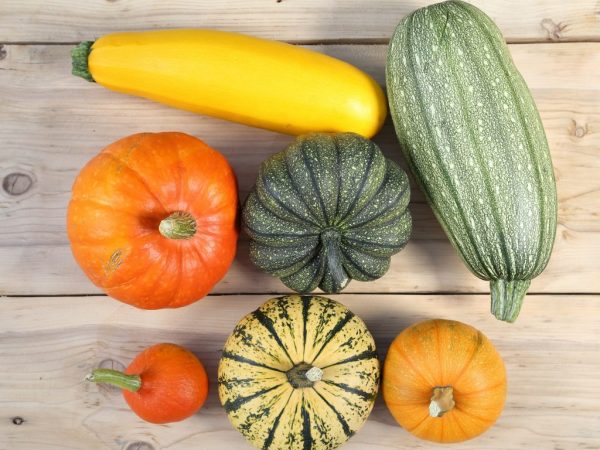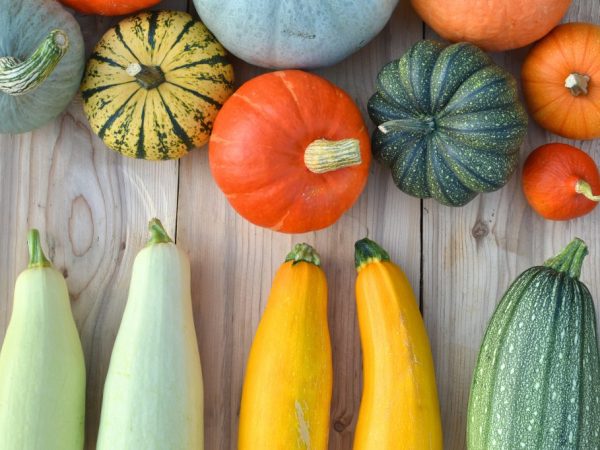What is the difference between pumpkin and zucchini
Pumpkin and squash are crops that belong to the same family and have a number of similar characteristics. They are unpretentious in care, have a high yield, high taste. Outwardly, young plants are almost indistinguishable: massive leaves, large yellow flowers, even the fruits are very similar at first. Let's find out how to distinguish a pumpkin from a squash and how they are separated from each other.

What is the difference between pumpkin and zucchini
The main differences
Seeds
An experienced gardener can quickly identify a particular species even before planting.
Zucchini seeds:
- slightly convex, oval shape;
- thin skin of light color;
- easily separates into cotyledons.
Pumpkin seeds:
- rounded, flat shape;
- thick, rough yellow rind;
- difficult to disclose.
Plant
The pumpkin rises quickly. The sprouts are strong, stocky. The leaves are rather coarse and thick. She always spins and has leaves that are shaped like a burdock with teeth. Blooming along the lash.
Zucchini emerge a little later. They grow in bush. They have more elongated, rounded light green carved leaves. Flowers appear in the middle of the bush
These signs do not always work due to the large number of species of these crops. The final point can be put only after the appearance of the first fruits.
Fruit
Zucchini
- Always elongated or oval (sometimes curved).
- Fruit color ranges from white to green. There are striped varieties.
Only young fruits are eaten. The taste is rather bland, from which snacks are prepared or harvested as pickles. They are low in calories and are part of many diets.
The first crop can be harvested in 50 days or a little later after germination.
Pumpkin
- The fruits are usually round. Although there are also elongated varieties, you cannot confuse them with zucchini - they are much larger than it.
- The pulp has a specific pumpkin smell, fibrous, orange in color, covered with a dense crust on top.
The taste is significantly different: it is sweeter, juice is made from it, mashed potatoes are prepared, added to porridge. Only ripe fruits are eaten (from the end of summer to the first frost).
Unripe pumpkin is removed to a warm storage room and fully ripe.
Similarities

Pumpkins and courgettes have similar fruit storage requirements.
Both species belong to the same family - pumpkin. Both love warmth: the optimum temperature should be around 25 °. They grow well on light loamy soils, compost heaps, ordinary manure is quite suitable as a top dressing.
Seedlings are planted at the same time, in the future, the plants must be protected from frost, at first, weeds must be destroyed and watered with warm water.
Both squash and pumpkin can be grown in seedlings and in the usual way (planting in open ground).
They have the same diseases (powdery mildew, root rot) and methods of treatment.
The methods of storing the crop after harvest are very similar.In some cases, artificial pollination is required for higher yields (rainy summers or lack of pollinating insects).
Landing features
You can plant vegetables nearby, but still it is undesirable to do this.
Especially if you plan to receive seeds for planting next year. These plants are very easily pollinated.
There won't be much change in the first year. But the next one you can get a kind of hybrid with thick skin and rough pulp instead of tender zucchini. Or a white mutant pumpkin.
Therefore, there should be a decent distance between the beds and it is desirable to find a third culture. If you buy seeds every season, you don't have to worry. Joint planting will not affect the quality of the crop. Plants grow and bear fruit well.
Storage periods
Zucchini has a very limited fresh shelf life.
The most delicious zucchini is young, unripe, with soft seeds that have just begun to form. It is eaten with the skin, raw or after heat treatment, the pulp is tender, light in color.
On the contrary, pumpkin is eaten only when fully ripe, when the pulp is filled with sweet juice, and the seeds are covered with a dense shell. Her surface is rough, has a shell layer, thanks to which the fruits are stored for a long time. The pulp is usually used for making desserts, salads, added to meat.
The nutritional value of pumpkin is higher. Pumpkin seed oil is squeezed out of the seeds, which is used in cosmetology, medicine and cooking.
Summing up
Despite belonging to the same family, pumpkin and squash are different plants.
The main differences are:
- the size and shape of the seeds;
- leaf and stem shape;
- seedling germination time;
- the size and shape of the fruit;
- ripening time;
- fruit taste;
- the difference in the chemical composition of the fruit;
- differences in cooking methods.
Common signs:
- growth requires the same conditions;
- both species are thermophilic;
- have external similarity;
- some varieties of zucchini form a whip;
- can be pollinated.
Ripe zucchini lose some of their taste, but they are well stored in a well-ventilated room. Pumpkin does not lose its properties and is capable of long-term storage.

